Wistron NeWeb MS2143RM8 Notebook Computer with Built In Wireless LAN User Manual Aspire 1500
Wistron NeWeb Corporation Notebook Computer with Built In Wireless LAN Aspire 1500
Contents
- 1. Users Manual Revised
- 2. RF Module Manual
- 3. DoC
Users Manual Revised
Acer Aspire 1500 series
User’s Guide
Model
MS2143
Changes may be made periodically to the information in this publication without obligation
to notify any person of such revision or changes. Such changes will be incorporated in new
editions of this manual or supplementary documents and publications. This company makes
no representations or warranties, either expressed or implied, with respect to the contents
hereof and specifically disclaims the implied warranties of merchantability or fitness for a
particular purpose.
Record the model number, serial number, purchase date, and place of purchase information in
the space provided below. The serial number and model number are recorded on the label
affixed to your computer. All correspondense concerning your unit should include the serial
number, model number, and purchase information.
No part of this publication may be reproduced, stored in a retrieval system, or transmitted, in
any form or by any means, electronic, mechanical, photocopy, recording, or otherwise,
without the prior written permission of Acer Incorporated.
Model Number : _________________________________
Serial Number: ___________________________________
Purchase Date: ___________________________________
Place of Purchase: ________________________________
Copyright © 2003
All Rights Reserved
Acer Aspire 1500 Series Notebook Computer User's Guide
Original Issue: December 2003
Acer Aspire 1500 series Notebook computer
All trademarks and registered trademarks are the properties of their respective companies.

iii
English
English
First things first
Yo u r g u i d e s
A set of guides is provided to help you set up and use your Aspire
computer:
For more information on Acer’s products, services, and support,
please visit the web site: http://www.acer.com.
Basic care and tips for using your computer
Turning your computer on and off
To turn on your computer, open the lid and press the power button
above the keyboard.
To turn the power off, you can do any of the following:
• Click on the Start button in Windows, and then select Shut Down
on the popup menu.
• Push the power button.
To use this method, you must first click on the Power
Management icon in Windows Control Panel, and then check
that the power button is set to shut down the computer when
pressed. See Windows Help for more information.
The Just for starters… poster shows you how to set up
your computer.
This User's Guide provides clear and concise information
on using your computer productively. You are advised to
read it thoroughly and keep it handy for future reference.

iv
English
Note: If you are unable to shut down the computer in the usual
way, press and hold the power button for more than four seconds.
You should then wait at least two seconds before turning the
computer on again.
Taking care of your computer
Your computer will serve you well if you take care of it.
• Do not expose the computer to direct sunlight. Do not place it
near sources of heat, such as a radiator.
• Do not expose the computer to temperatures below 0°C (32°F), or
above 50°C (122°F).
• Do not expose the computer to magnetic fields.
• Do not expose the computer to rain or moisture.
• Do not spill water or any liquid on the computer.
• Do not subject the computer to heavy shock or vibration.
• Do not expose the computer to dust or dirt.
• Do not place objects on top of the computer.
• Do not slam the lid shut. Close the computer gently.
• Do not place the computer on unstable or uneven surfaces.
Taking care of your AC adapter
It is important that you look after your AC adapter.
• Do not connect the adapter to any other device.
• Do not step on the power cord or place heavy objects on it. Route
the power cord away from areas where people might walk on it or
trip over it.
• Do not pull on the power cord when disconnecting from the mains
power socket. Grasp and pull the plug instead.
• The total ampere ratings of equipment plugged into a power strip
should not exceed the ampere rating for that power strip.

v
English
English
Taking care of your battery pack
It is also important that you look after your computer's battery pack.
• Use the correct battery model for your computer. Do not use other
kinds of batteries.
• Turn the power off before removing or replacing the battery.
• Do not tamper with the battery. Keep the battery away from
children.
• Dispose of batteries according to local regulations. Recycle if
possible.
Cleaning and servicing
When cleaning your computer, it is important that you follow these
steps:
• Turn off the computer and remove the battery.
• Disconnect the AC adapter.
• Clean with a soft cloth moistened with a little water. Do not use
liquid or aerosol cleaners.
Refer to the chapter entitled “Frequently asked questions” on page 63
if any of the following occurs:
• You drop the computer or damage the case.
• You spill liquid on the computer.
• The computer does not operate normally.

vi
English
English
First things first iii
Your guides iii
Basic care and tips for using your computer iii
Getting familiar with your computer 1
A tour of your computer 3
Front view 3
Left view 5
Right view 6
Rear view 7
Bottom view 8
Features 9
Indicators 11
Keyboard 13
Special keys 13
Touchpad 19
Touchpad basics 19
Launch keys 21
Storage 22
Inserting and ejecting a diskette 22
Ejecting the optical drive tray 23
Emergency ejection of the optical drive tray 23
Connectivity options 24
Ethernet and LAN 24
Fax/data modem 25
Audio 26
Securing your computer 27
Security slot 27
Operating on battery power 29
Battery pack 31
Battery pack characteristics 31
Installing and removing the battery pack 32
Charging the battery 33
Checking the battery level 33
Optimizing battery life 33
Battery-low warning 34
Power management 35
Peripherals and options 37
External display devices 39
External input devices 39
Contents

English
External keyboard 39
External keypad 39
External pointing device 39
USB devices 40
IEEE 1394 Port 41
Printer 42
Audio devices 42
Expansion devices 43
PC Card 43
Miscellaneous options 45
Battery pack 45
AC adapter 45
Key component upgrades 46
Memory upgrade 46
Hard disk upgrade 47
Moving with your computer 49
Disconnecting from the desktop 51
Moving around 52
Preparing the computer 52
What to bring to short meetings 52
What to bring to long meetings 52
Taking the computer home 53
Preparing the computer 53
What to bring with you 53
Special considerations 53
Setting up a home office 54
Traveling with the computer 54
Preparing the computer 54
What to take with you 54
Special considerations 54
Traveling internationally with your computer 55
Preparing the computer 55
What to take with you 55
Special considerations 55
Software 57
System software 59
Launch Manager 59
BIOS Setup Utility 60

English

Getting familiar with
your computer

Your Aspire 1500 series notebook computer
combines solid performance, versatility,
multimedia capabilities and portability with
a stylish design. Increase your productivity
by working wherever you are.
This chapter provides an in-depth "tour" of
your computer's features.
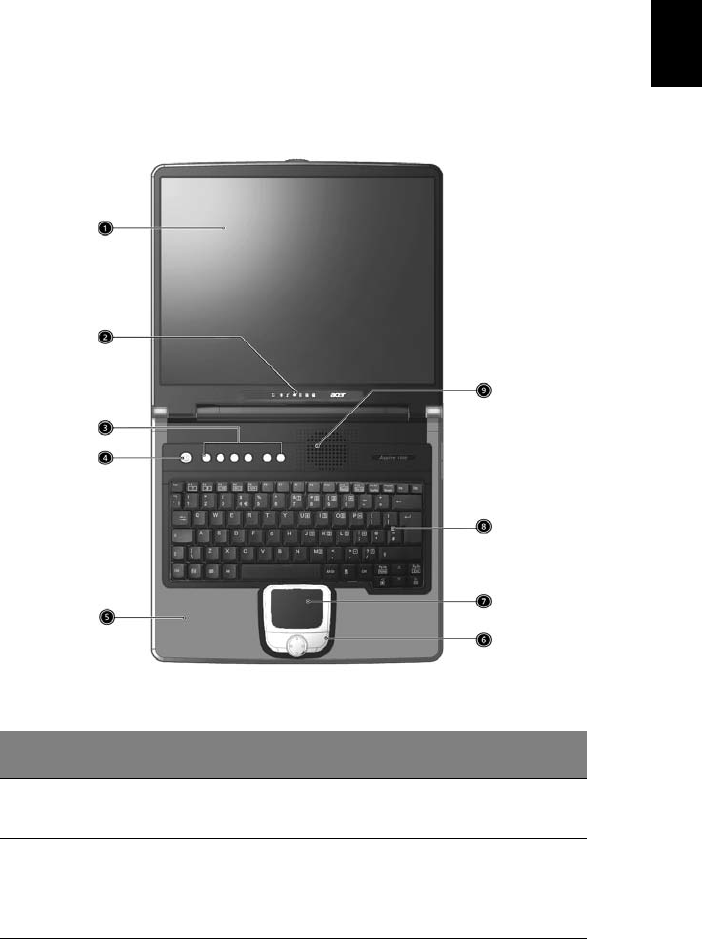
3
English
English
A tour of your computer
After setting up your new Aspire notebook computer, as illustrated in
the Just for starters… poster, take a few minutes to explore the unit.
Front view
#Item Description
1 Display screen Liquid-crystal display (LCD) provides
visual output.
2 Status indicators Light-emitting diodes (LEDs) that turn
on and off to show the status of the
computer, its functions and
components.
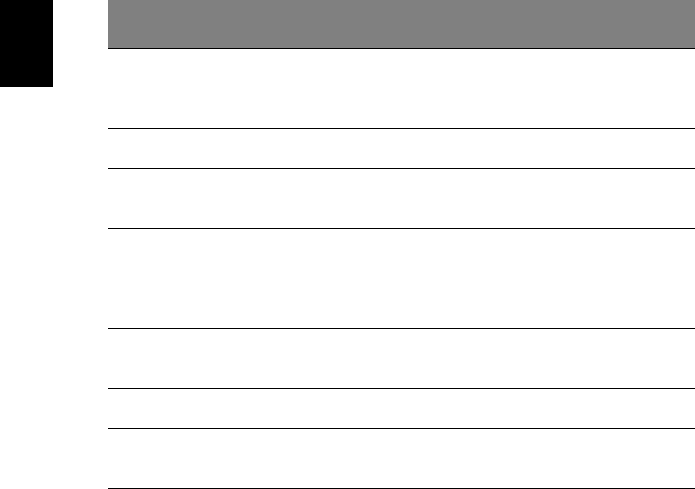
Getting familiar with your computer
4
English
3 Launch keys Buttons for launching frequently used
programs. See“Launch keys” on page
21 for more details.
4 Power button Turns the computer on and off.
5 Palmrest Comfortable support area for your
hands when you use the computer.
6 Click buttons &
4-way scroll key
The left and right buttons function like
the left and right mouse buttons; the
4-way scroll key scrolls the contents of
a window up, down, left and right.
7 Touchpad Touch-sensitive pointing device which
functions like a computer mouse.
8 Keyboard Inputs data into your computer.
9 Ventilation Slot Enables the computer to stay cool,
even after prolonged use.
#Item Description
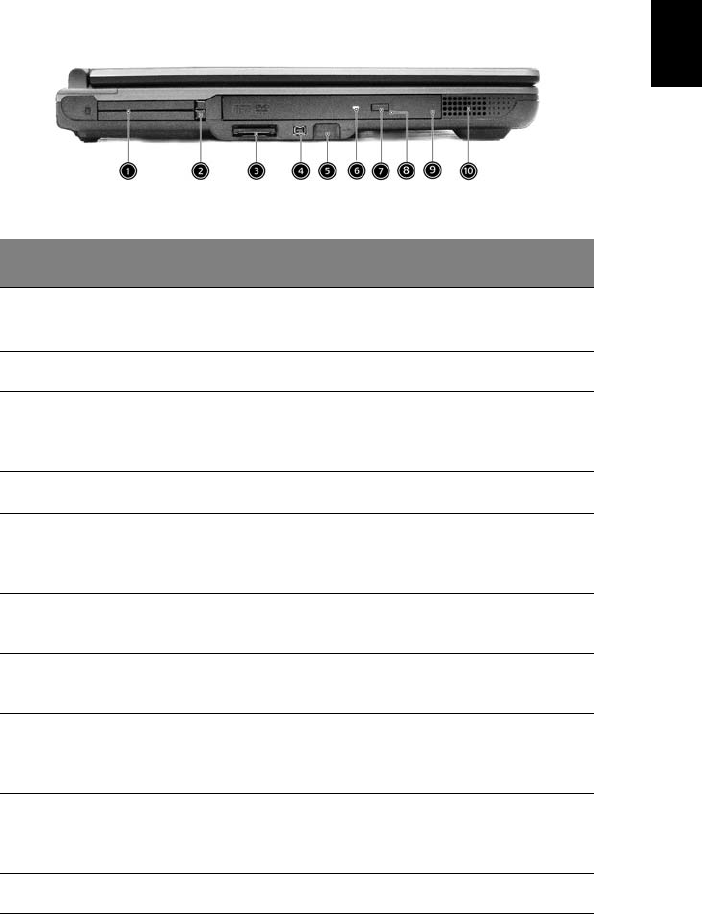
5
English
English
Left view
#Item Description
1 PC Card slots Support two Type II or one Type III
CardBus PC Card(s).
2 Eject buttons Ejects the PC Card(s) from the slots.
3 3-in-1 card reader Supports Secure Digital (SD),
MultiMedia Card (MMC) and Memory
Stick (MS) formats.
4IEEE 1394 port Connects to IEEE 1394 devices.
5Infrared port Interfaces with infrared devices
(e.g., infrared printer and IR-aware
computer).
6LED indicator Lights up when the optical drive is
active.
7Eject button Ejects the optical drive tray from the
drive.
8 Emergency eject slot Ejects the optical drive tray when the
computer is turned off.
See page 23 for more details.
9 Optical drive Internal optical drive; accepts CDs or
DVDs depending on the optical drive
type.
10 Speaker Delivers stereo audio output.
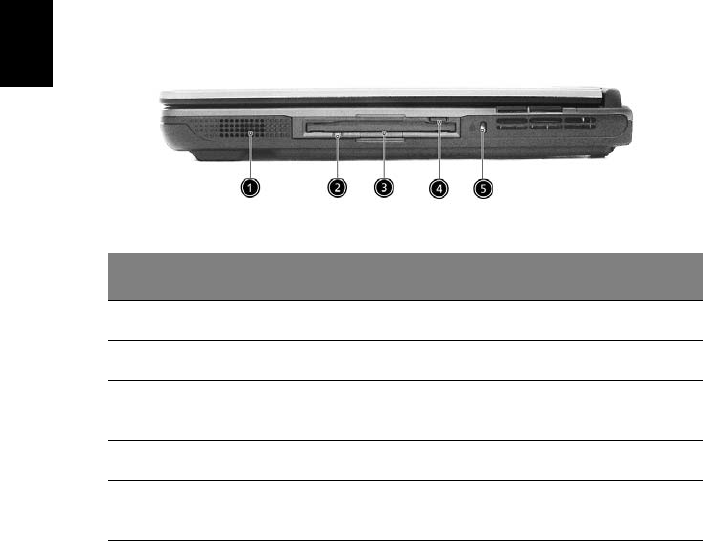
Getting familiar with your computer
6
English
Right view
#Item Description
1 Speaker Delivers stereo audio output.
2 Floppy activity indicator Lights up when the floppy is active.
3 Floppy drive Internal diskette drive; accepts a
3.5-inch diskette.
4 Floppy disk eject button Push to eject the floppy disk.
5 Security keylock Connects to a Kensington-compatible
computer security lock.

7
English
English
Rear view
#Item Description
1 Power jack Connects to an AC adapter.
2 Parallel port Connects to a parallel device
(e.g., parallel printer).
3 S-video port Connects to a television or display device
with S-video input.
4 External display port Connects to a display device (e.g., external
VGA monitor and LCD projector).
5 Four USB 2.0 ports Connect to Universal Serial Bus (USB) 2.0
devices (e.g., USB mouse and USB camera).
6 Network jack Connects to an Ethernet Gigabit LAN
network.
7 Modem jack Connects to a phone line.
8 Speaker/line-out/
headphone jack
Connects to audio line-out devices
(e.g., speakers and headphones).
9 Line-in/mic-in jack Accepts audio line-in devices
(e.g., audio CD player and stereo walkman).
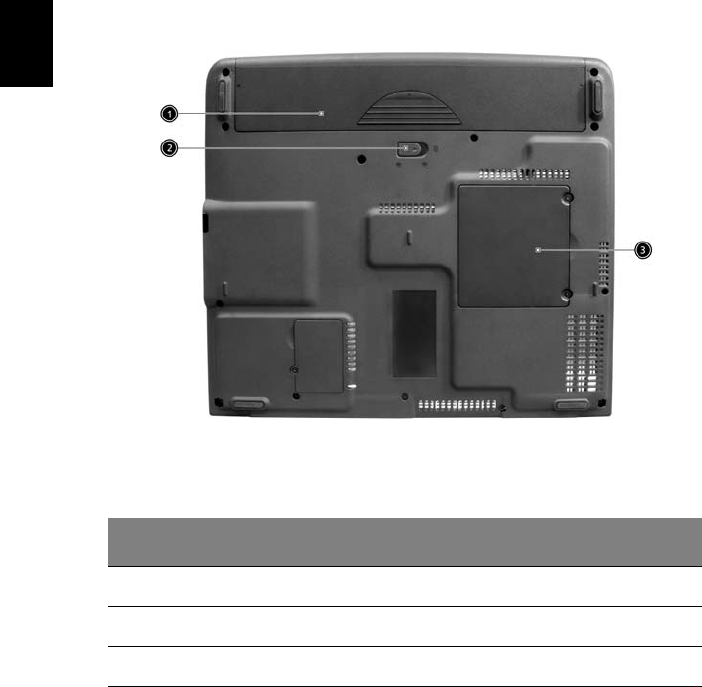
Getting familiar with your computer
8
English
Bottom view
#Item Description
1 Battery bay Houses the computer's battery pack.
2 Battery release latch Unlatches to remove the battery pack.
3 Memory compartment Houses the computer's main memory.

9
English
English
Features
Performance
• The AMD AthlonTM 64 processor
3000+ ~ 3400+.
• AMD Hyper Transport technology.
• Two memory slots supporting 333 MHz DDR, upgradeable to 2GB
(Memory modules are strictly required to be JEDEC compliant).
• High-capacity, Enhanced-IDE hard disk.
Display
• The 14.1” XGA (1024x768 resolution), or 15.0” SXGA+ (1400x1050
resolution) TFT LCD panel provides a large viewing area for
maximum efficiency and ease-of-use.
• 3D graphics support.
• Supports simultaneous display between LCD and CRT display.
• S-video for output to a television or display device that supports
S-video input.
• “Automatic LCD dim” feature that automatically selects the best
setting for the display in order to conserve power.
• DualViewTM support.
Multimedia
• High-speed built-in optical drive:
CD-ROM, DVD-ROM, DVD/CD-RW combo, or DVD-Dual.
•MS DirectSound compatible.
• Built-in dual speakers.
Connectivity
• Integrated Gigabit Ethernet connection.
• Built-in 56Kbps fax/data modem.
• Four universal serial bus (USB 2.0) ports.
• One IEEE 1394 port.
• IEEE 802.11g or IEEE 802.11a/g Wireless LAN (manufacturing option).
• Bluetooth (manufacturing option).

Getting familiar with your computer
10
English
Human-centric design
• All-in-one design (incorporating hard drive, optical drive and
floppy disk drive).
• Rugged, yet extremely portable, construction.
• Stylish appearance.
• Full-size keyboard with four programmable launch keys.
• Comfortable palm rest area with well-positioned touchpad.
Expansion
• PC card slot enables a range of add-on options.
• Upgradeable hard disk and memory modules.
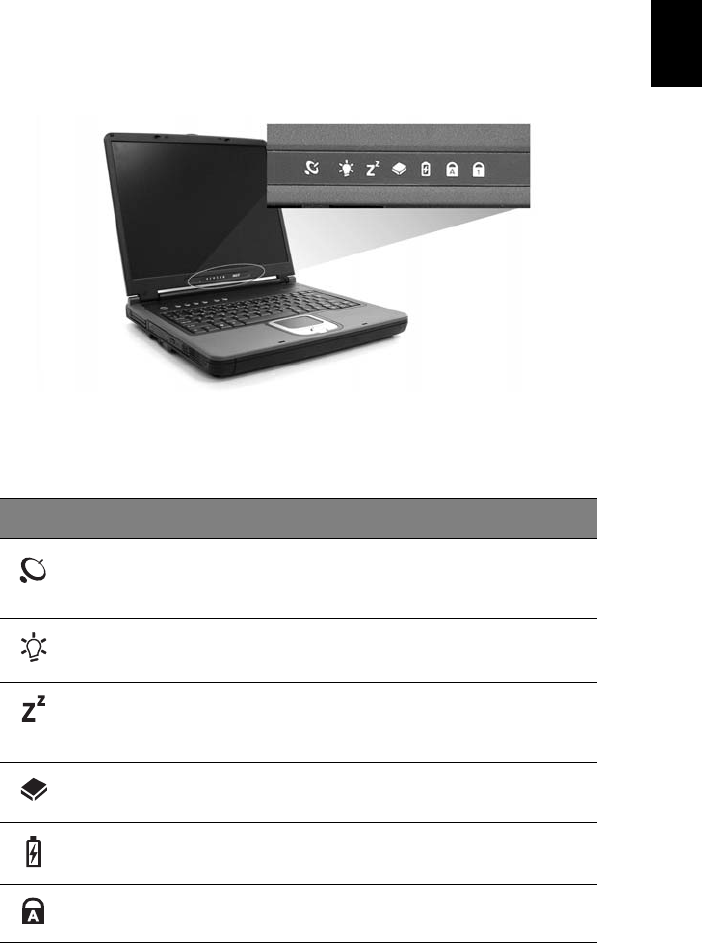
11
English
English
Indicators
Your computer provides an array of six indicators located below the
dispaly screen, showing the status of the computer and its
components.
The Power and Sleep status icons are visible even when you close the
display cover so you can see the status of the computer while the cover
is closed.
Icon Function Description
Wireless
communication
button
Lights when the Wireless LAN capability is
enabled.
Power Lights when the computer is on.
Sleep Lights when the computer enters Standby
mode, and blinks when it enters into or resumes
from hibernation mode.
Media activity Lights when the floppy drive, hard disk or
optical drive is active.
Battery charge Lights when the battery is being charged.
Caps Lock Lights when Caps Lock is activated.
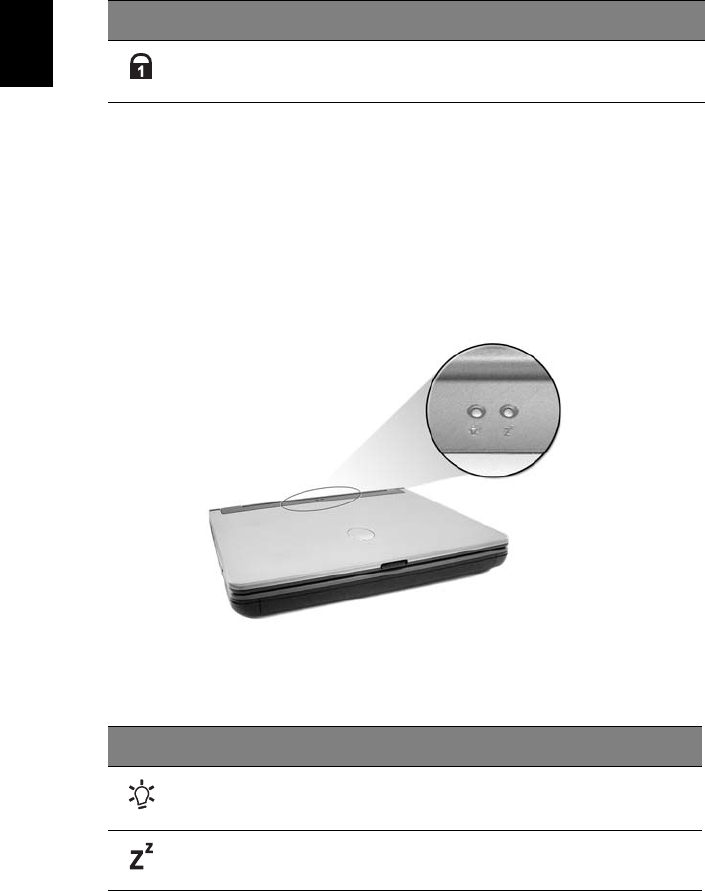
Getting familiar with your computer
12
English
Indicators on cover
When the cover of your computer is closed, 2 easy-to-read icons are
shown, indicating which state or feature is enabled or disabled.
Num Lock Lights when Num Lock is activated.
Icon Description
Lights up when the computer is on.
Lights when the computer enters Standby mode, and blinks
when it enters into or resumes from hibernation mode.
Icon Function Description
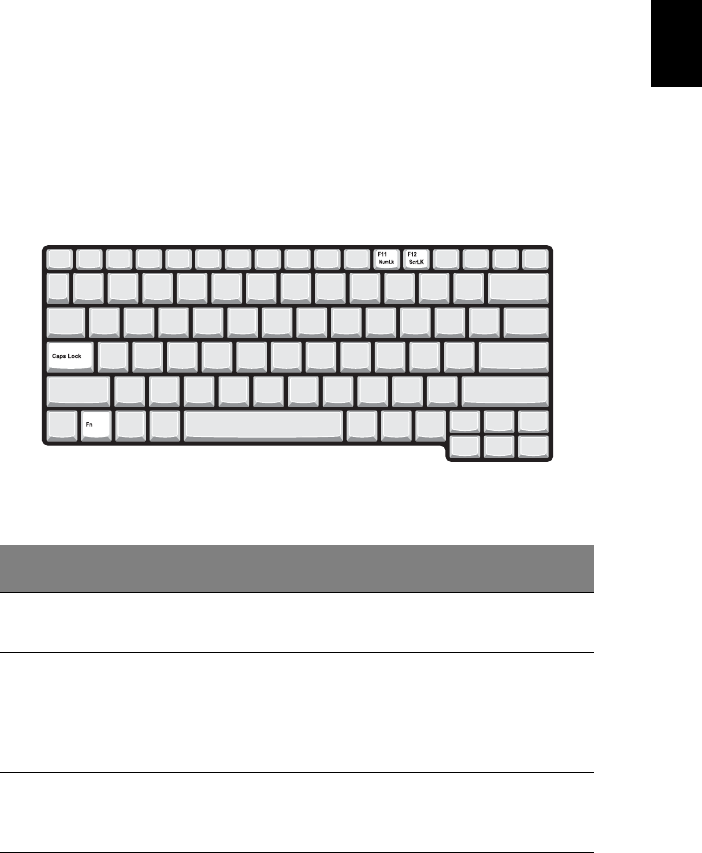
13
English
English
Keyboard
The keyboard features full-size keys with an embedded keypad,
separate cursor control keys, two Windows keys, and twelve function
keys (hot keys).
Special keys
Lock keys
The keyboard has three lock keys which you can toggle on and off
Lock Key Description
Caps Lock When Caps Lock is on, all alphabetic characters typed are in
uppercase.
Num Lock
(Fn+F11)
When Num Lock is on, the embedded keypad is in numeric
mode. The keys function as a calculator (complete with the
arithmetic operators +, -, *, and /). Use this mode when you
need to do a lot of numeric data entry. A better solution
would be to connect an external keypad.
Scroll Lock
(Fn+F12)
When Scroll Lock is on, the screen moves one line up or down
when you press the up or down arrow keys respectively.
Scroll Lock does not work with some applications.

Getting familiar with your computer
14
English
Embedded keypad
The embedded numeric keypad functions like a desktop numeric
keypad. It is indicated by small characters located on the upper right
corner of the keycaps. To simplify the keyboard legend, cursor-control
key symbols are not printed on the keys.
Desired Access Num Lock On Num Lock Off
Number keys on
embedded keypad
Type numbers using
embedded keypad in a
normal manner.
Cursor-control keys
on embedded
keypad
Hold Shift while using
cursor-control keys.
Hold Fn while using
cursor-control keys.
Main keyboard keys Hold Fn while typing letters
on embedded keypad.
Type the letters in a
normal manner.
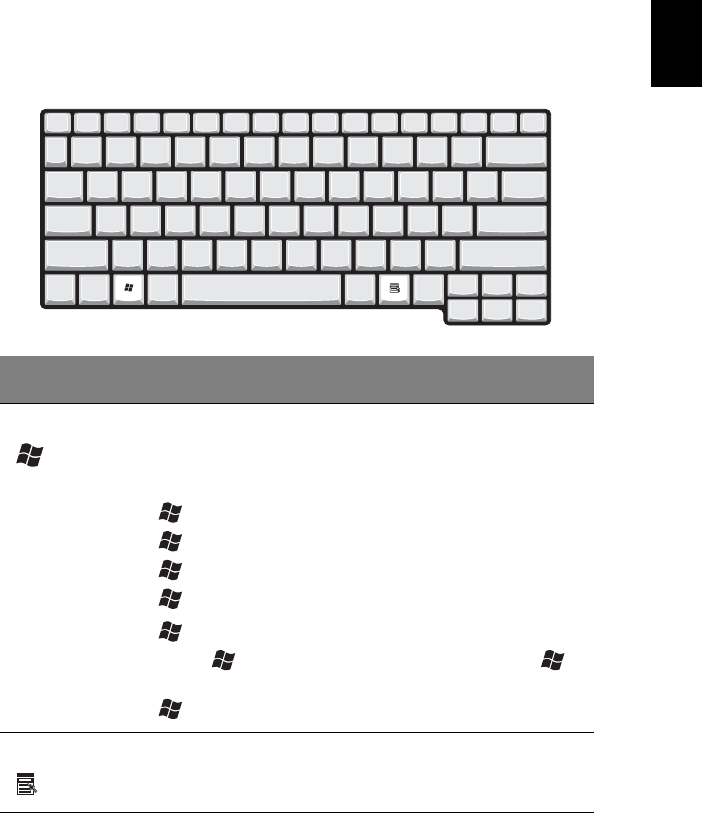
15
English
English
Windows keys
The keyboard features two keys that provide Windows-specific
functions.
Key Description
Windows key Pressed alone, this key has the same effect as clicking on
the Windows Start button; it launches the Start menu. It
can also be used with other keys to provide a variety of
functions:
+ Tab activates the next Taskbar button.
+ E opens the My Computer window.
+ F1 opens Help and Support.
+ F opens the Find: All Files dialog box.
+ M minimizes all windows.
Shift + + M undoes the minimize all windows ( +
M) action.
+ R opens the Run dialog box.
Application key This key has the same effect as clicking the right mouse
button; it opens the application's context menu.
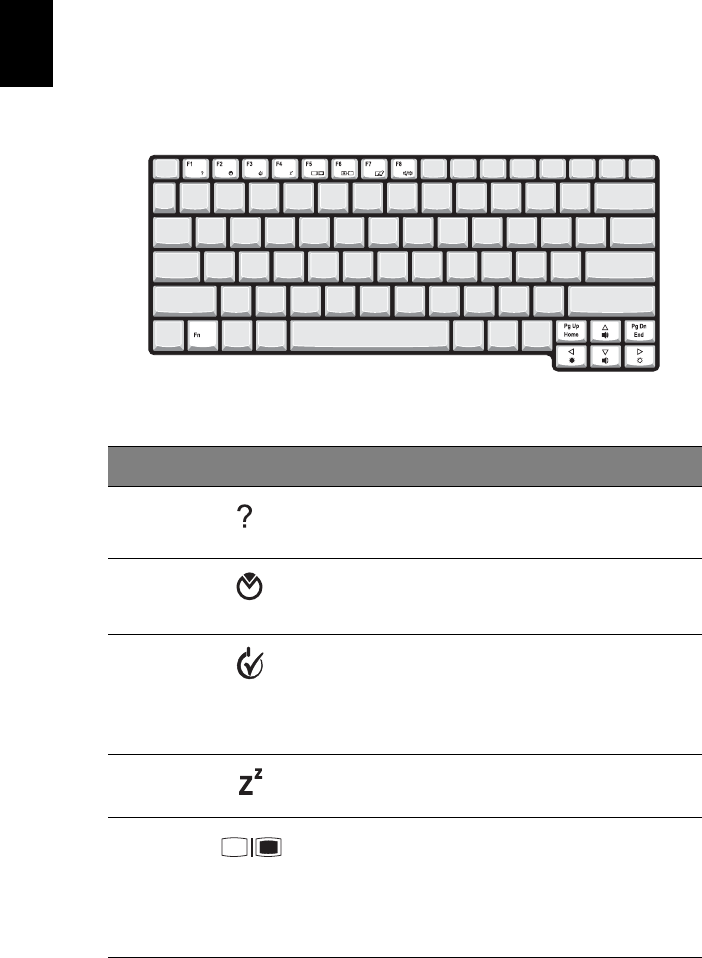
Getting familiar with your computer
16
English
Hot keys
Using the Fn key with another key creates a hot key, providing a quick
and convenient method for controlling various functions.
To use a hot key, first hold down the Fn key. Next, press the second key
in the combination. Finally, release both keys.
Your computer provides the following hot keys:
Hot Key Icon Function Description
Fn-F1 Hot key help Displays help on hot keys.
Fn-F2 Setup Accesses the computer’s
property window.
Fn-F3 Power
Management
Scheme toggle
Switches the power
management scheme used by
the computer (function
available if supported by
operating system).
Fn-F4 Sleep Puts the computer in Sleep
mode.
Fn-F5 Display toggle Switches display output
between the display screen,
external monitor (if
connected) and both the
display screen and external
monitor.
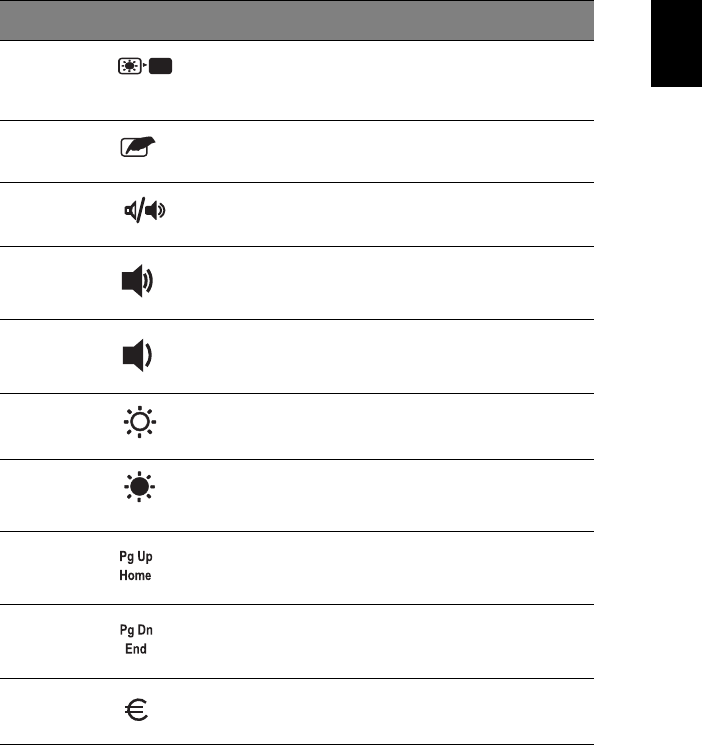
17
English
English
Fn-F6 Screen blank Turns the display screen
backlight off to save power.
Press any key to return.
Fn-F7 Touchpad toggle Turns the internal touchpad
on and off.
Fn-F8 Speaker toggle Turns the speakers on and off.
Fn-↑Volume up Increases the sound volume.
Fn-↓Volume down Decreases the sound volume.
Fn-→Brightness up Increases the screen
brightness.
Fn-←Brightness down Decreases the screen
brightness.
Fn-PgUp Home Functions as the “Home” key.
Fn-PgDn End Functions as the “End” key.
Alt Gr-
Euro
Euro Types the Euro symbol.
Hot Key Icon Function Description
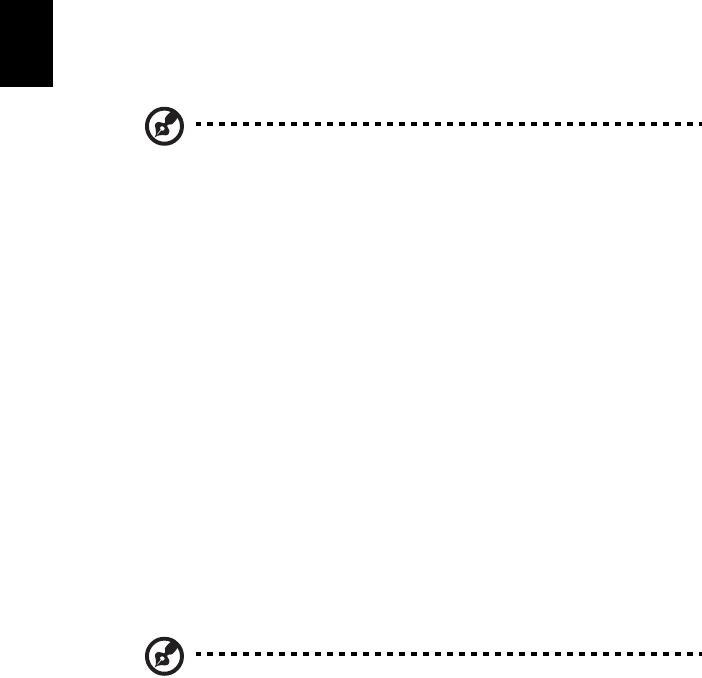
Getting familiar with your computer
18
English
The Euro symbol
If your keyboard layout is set to United States-International or United
Kingdom or if you have a keyboard with a European layout, you can
type the Euro symbol on your keyboard.
Note for US keyboard users: The keyboard layout is set when
you first set up Windows. For the Euro symbol to work, the
keyboard layout has to be set to United States-International.
To verify the keyboard type:
1 Click on Start, Control Panel.
2 Double-click on Regional and Language Options.
3 Click on the Language tab and click on Details.
4 Verify that the keyboard layout used for "En English (United
States)" is set to United States-International.
If not, select and click on ADD; then select United States-
International and click on OK.
5 Click on OK.
To type the Euro symbol:
1Locate the Euro symbol on your keyboard.
2Open a text editor or word processor.
3Hold Alt Gr and press the Euro symbol.
Some fonts and software do not support the Euro symbol.
Please refer to http://www.microsoft.com/typography/faq/
faq12.htm for more information.
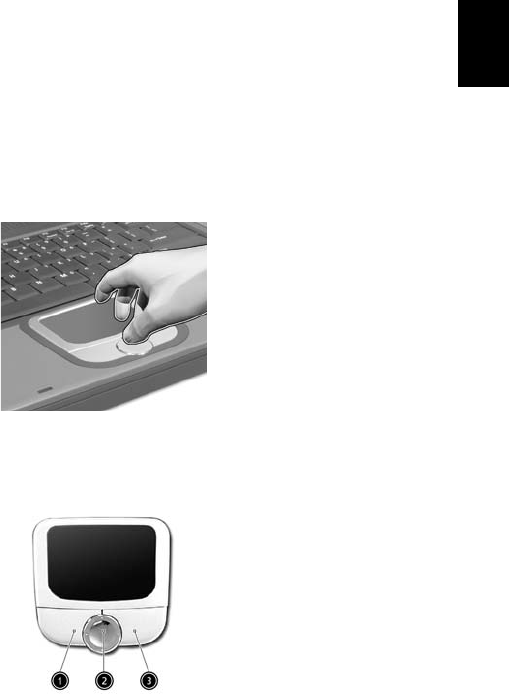
19
English
English
Touchpad
The built-in touchpad is a PS/2- compatible pointing device that senses
movement on its surface. The cursor responds to your finger
movements on the touchpad. In addition, the two click buttons
provide the same functionality as a computer mouse, while the scroll
key enables easy 4-way scrolling in documents and web pages.
The touchpad is located in the middle of the palm rest area, providing
maximum comfort and efficiency.
Touc hpad basi cs
Use the touchpad as follows:
• Slide your finger over the surface of the touchpad to control the
movement of the cursor. Tap the touchpad to perform selection
and execution functions.
• Press the left (1) and right (3) click buttons to perform selection
and execution functions, just as you would use the buttons on a
computer mouse.
• Use the scroll key (2) to scroll through long documents and web
pages. Press the top of the key to scroll up, bottom to scroll down;
left to scroll left, and right to scroll right.

Getting familiar with your computer
20
English
Note: Keep your fingers, as well as the surface of the touchpad,
clean and dry. The touchpad is sensitive to your finger movements:
the lighter your touch, the better the response. Tapping hard will
not increase the touchpad's responsiveness.
Function Left Button Right
Button
4-Way
Scroll Key Tap
Execute Click twice
quickly.
Tap twice
quickly.
Select Click once. Tap once.
Drag Click and hold.
Then, slide your
finger across
the touchpad to
drag the cursor
over the
selection.
Tap twice
quickly. On the
second tap,
slide your
finger across
the touchpad to
drag the cursor
over the
selection.
Access
content
menu
Click
once.
Scroll Click and
hold the up/
down/left/
right button.

21
English
English
Launch keys
Located at the top of the keyboard are six buttons. These buttons are
called launch keys. They are designated as mail button, Web browser
button, P1, P2, Bluetooth and Wireless buttons. The Wireless and
Bluetooth buttons cannot be set by the user. To set the other four
launch keys, run the Acer Launch Manager.
Caution: It’s important that the Bluetooth and Wireless LAN
features are turned off before boarding an airplane.
Launch Key Default application
1 Email Launches your email application.
2 Web browser Launches your Internet browser.
3 P1 User-programmable.
4 P2 User-programmable.
5 Bluetooth Enables your Bluetooth (manufacturing option).
6 InviLink Enables your 802.11g or 802.11a/g Wireless LAN.

Getting familiar with your computer
22
English
Storage
Your computer's all-in-one design offers a variety of data storage
options:
• The high capacity Enhanced-IDE hard disk drive.
The hard drive is upgradeable, enabling you to increase your
storage capacity in the future. Consult your dealer if you need to
upgrade.
• The floppy disk drive.
The floppy disk drive accepts a standard 1.44MB 3.5" diskette.
• The high speed optical drive.
Depending on your model, you have a CD-ROM, DVD-ROM,
DVD/CD-RW combo, or DVD-Dual drive. The optical drive provides
increased storage capacity, as well as offering a host of multimedia
possibilities.
See the section entitled “A tour of your computer” on page 3 for the
locations of these drives.
Inserting and ejecting a diskette
To insert a diskette in the floppy disk drive:
• Push the diskette into the drive. Make sure that the label is on the
outer edge, and facing upwards.
• The diskette will click in place, and the floppy disk eject button will
pop out.
To remove a diskette from the floppy disk drive:
• Push the floppy disk eject button.
• The diskette will be released, and partially pop out of the drive.
• Pull the diskette from the drive.
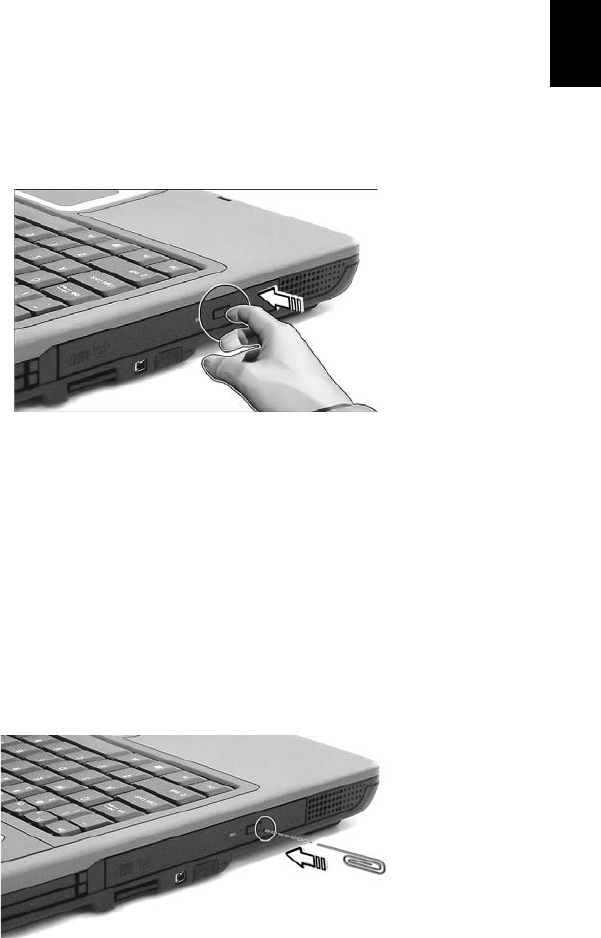
23
English
English
Ejecting the optical drive tray
To eject the optical drive tray:
• With the computer turned on, press the optical drive eject button.
• The tray will be released, and partially popped open.
• Gently pull the tray out to its limit.
To load an optical disc:
• Place a CD or DVD on the open tray. Align the disc's center hole
with the tray's spindle.
• Gently push down on the disc until it clicks in place on the spindle.
• Gently push in the tray until it clicks closed.
Emergency ejection of the optical drive tray
If you need to eject the optical drive tray when the computer is turned
off, push a straightened paper clip into the optical drive emergency
eject hole. The tray will be released, and partially popped open.

Getting familiar with your computer
24
English
Connectivity options
Your computer has built-in connectivity options, enabling you to hook
up to a network or communicate over a phone line.
Ethernet and LAN
The integrated network feature allows you to connect your computer
to an Ethernet-based (10/100/1000 BASE-T) network.
To use the network feature, plug an Ethernet cable into your
computer's network jack, and then connect the other end to a network
jack or hub on your network.
See Windows Help for information on setting up a network
connection.
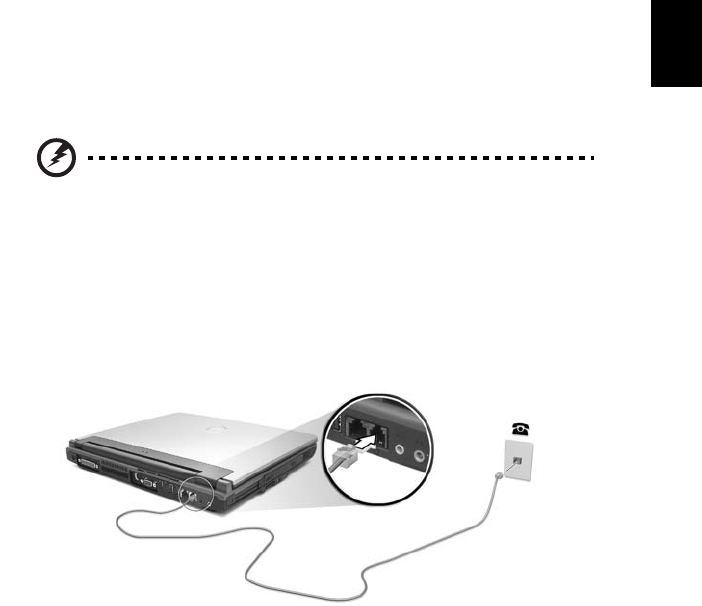
25
English
English
Fax/data modem
Your computer features a built-in fax/data modem, enabling you to
communicate over a phone line. This means that you can connect to
the Internet via a dialup account with an ISP, log in to your network
from a remote location, or send faxes.
Warning: Your modem is not compatible with digital phone
lines. Plugging the computer into a digital phone system
will damage the modem.
To use the fax/data modem, plug a phone cable into your computer's
modem jack, and then connect the other end to a telephone jack.
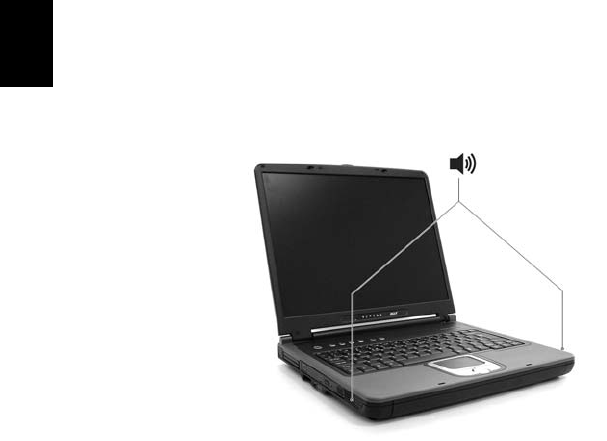
Getting familiar with your computer
26
English
Audio
Your computer includes an integrated stereo audio system.
Built-in stereo speakers are located at the front on both sides of the
unit.
Volume is adjusted using software, such as Volume Control in
Windows, Volume Fn keys, or any other application that provides a
volume adjustment control.
Two audio ports on the rear side of the computer enable external
devices to be connected. See "A tour of your computer" for the
location of the audio ports. For information on connecting external
devices, see "Audio devices" in the section entitled, "Peripherals and
options."
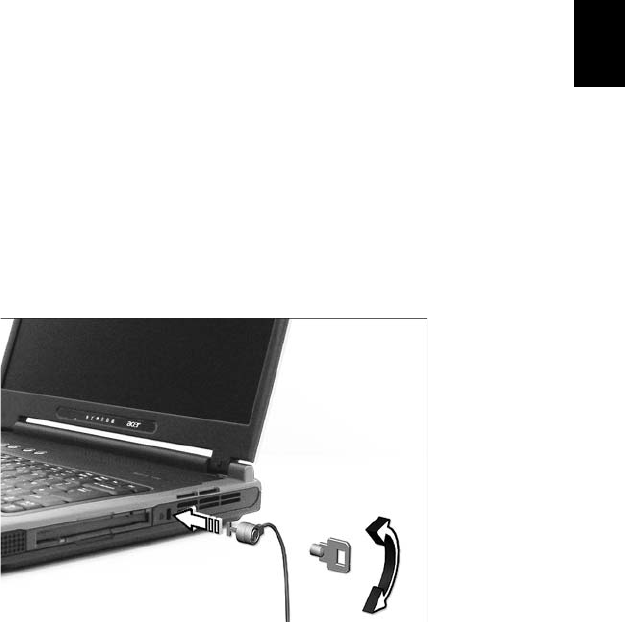
27
English
English
Securing your computer
Your computer features hardware and software security solutions, in
the form of a slot for a Kensington lock and a password facility.
Security slot
A slot for a Kensington slot enables you to physically protect your
computer from theft. Use this feature as follows:
• Wrap a security lock cable around a heavy or immoveable object,
such as a drawer handle on a file cabinet, or a table leg.
• Insert the lock into the slot on the computer, turn it 90°, and then
lock it in place.

Getting familiar with your computer
28
English

Operating on
battery power

Your Aspire 1500 series notebook computer
operates on battery or AC power.
This chapter provides information for
operating on battery power, as well as
information on how your computer
manages and saves power.

31
English
English
Battery pack
The computer uses a battery pack that gives you long use between
charges.
Battery pack characteristics
The battery pack has the following characteristics:
• Employs current battery technology standards.
• Delivers a battery-low warning.
The battery is recharged whenever you connect the computer to the
mains power supply. Your computer supports charge-in-use, enabling
you to recharge the battery while you continue to operate the
computer. However, recharging with the computer turned off results in
a significantly faster charge time.
The battery will come in handy when you travel or during a power
failure. It is advisable to have an extra fully charged battery pack
available as backup. Contact your dealer for details on ordering a spare
battery pack.
Maximizing the battery's life
Like all other batteries, your computer's battery will degrade over
time. This means that the battery's performance will diminish with
time and use. To maximize your battery's life, you are advised to
adhere to the recommendations set out below.
Conditioning a new battery pack
Before you use a battery pack for the first time, there is a
"conditioning" process that you should follow:
1 Insert the new battery without turning the computer on.
2 Connect the AC adapter and fully charge the battery.
3 Disconnect the AC adapter.
4 Turn on the computer and operate using battery power.
5 Fully deplete the battery until the battery-low warning appears.
6 Reconnect the AC adapter and fully charge the battery again.
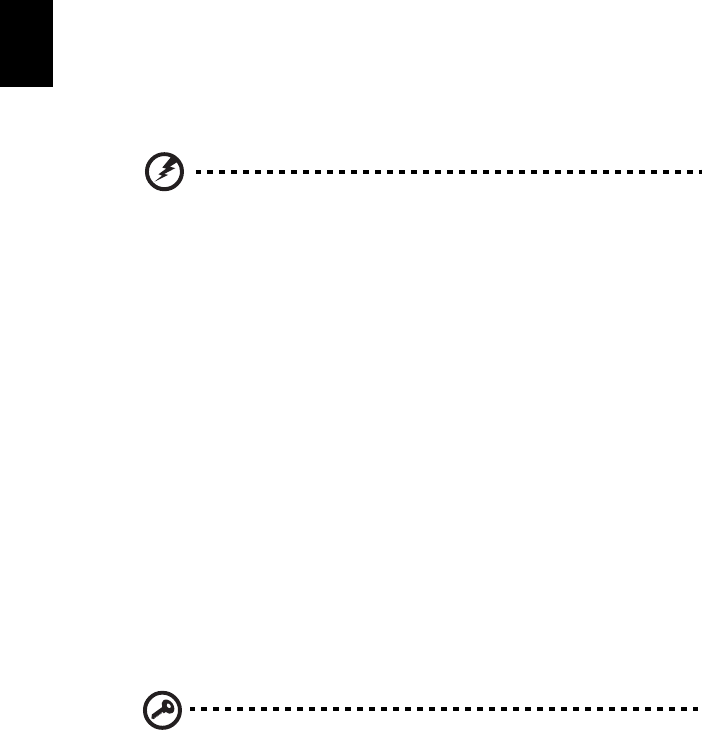
Operating on battery power
32
English
Follow these steps again until the battery has been charged and
discharged three times.
Use this conditioning process for all new batteries, or if a battery hasn't
been used for a long time. If the computer is to be stored for more
than two weeks, you are advised to remove the battery pack from the
unit.
Warning: Do not expose battery packs to temperatures
below 0°C (32°F) or above 60°C (140°F). Extreme
temperatures may adversely affect the battery pack.
By following the battery conditioning process you condition your
battery to accept the maximum possible charge. Failure to follow this
procedure will prevent you from obtaining the maximum battery
charge, and will also shorten the effective lifespan of the battery.
In addition, the useful lifespan of the battery is adversely affected by
the following usage patterns:
• Using the computer on constant AC power with the battery
inserted. If you want to use constant AC power, you are advised to
remove the battery pack after it is fully charged.
• Not discharging and recharging the battery to its extremes, as
described above.
• Frequent use; the more you use the battery, the faster it will reach
the end of its effective life. A standard computer battery has a life
span of about 500 charges.
Installing and removing the battery pack
Important! Before removing the battery from the unit, connect
the AC adapter if you want to continue using your computer.
Otherwise, turn off the computer first.
To install a battery pack:
1 Align the battery with the open battery bay; make sure that the
end with the contacts will enter first, and that the top surface of
the battery is facing up.
2 Slide the battery into the battery bay and gently push until the
battery locks in place.

33
English
English
To remove a battery pack:
1 Slide the battery release latch to release the battery.
2 Pull the battery from the battery bay.
Charging the battery
To charge the battery, first make sure that it is correctly installed in the
battery bay. Plug the AC adapter into the computer, and connect to a
mains power outlet. You can continue to operate your computer on AC
power while your battery is charging. However, charging the battery
with the computer turned off results in a significantly faster charge
time.
Note: You are advised to charge the battery before retiring for
the day. Charging the battery overnight before traveling enables
you to start the next day with a fully charged battery.
Checking the battery level
The Windows Power Meter indicates the current battery level. Rest the
cursor over the battery/power icon on the taskbar to see the battery's
present charge level.
Optimizing battery life
Optimizing battery life helps you get the most out of battery
operation, prolonging the charge/recharge cycle and improving
recharging efficiency. You are advised to follow the suggestions set out
below:
• Purchase an extra battery pack.
• Use AC power whenever possible, reserving battery for on-the-go
use.
• Eject a PC card if it is not being used, as it will continue to draw
power.
• Store the battery pack in a cool, dry place. The recommended
temperature is 10°C to 30°C. Higher temperatures cause the
battery to self-discharge faster.
• Excessive recharging decreases the battery life.
• Look after your AC adapter and battery.

Operating on battery power
34
English
Battery-low warning
When using battery power pay attention to the Windows Power
Meter.
Warning: Connect the AC adapter as soon as possible after
the battery-low warning appears. Data will be lost if the
battery to become fully depleted and the computer shuts
down.
When the battery-low warning appears, the recommended course of
action depends on your situation:
Situation Recommended Action
The AC adapter
and a power
outlet are
available.
1. Plug the AC adapter into the computer, and then
connect to the mains power supply.
2. Save all necessary files.
3. Resume work.
Turn off the computer if you want to recharge the
battery rapidly.
An extra fully
charged battery
pack is available.
1. Save all necessary files.
2. Close all applications.
3. Shut down the operating system to turn off the
computer.
4. Replace the battery pack.
5. Turn on the computer and resume work.
The AC adapter or
a power outlet is
unavailable. You
have no spare
battery pack.
1. Save all necessary files.
2. Close all applications.
3. Shut down the operating system to turn off the
computer.

35
English
English
Power management
Your computer features a built-in power management unit that
constantly monitors system activity. System activity refers to any
activity involving one or more of the following devices: keyboard,
touchpad/mouse, floppy disk drive, hard disk drive, optical drive,
peripherals connected to the computer, and video memory. If no
activity is detected for a period of time (the settings are controlled in
Windows Power Management), the computer turns off some, or all, of
these devices in order to conserve power.
Your computer employs a power management scheme that supports
ACPI (Advanced Configuration and Power Interface), enabling
maximum power conservation without compromising system
performance. ACPI allows Windows to control the amount of power
given to each device attached to the computer. In this way, Windows
handles all power-saving chores for your computer. Refer to Windows
Help for more information.

Operating on battery power
36
English

Peripherals and
options

Your Aspire 1500 series notebook computer
offers good expansion capabilities.
This chapter provides information on
connecting peripherals to expand your
system. It also describes how to upgrade key
components to enhance system
performance and keep your computer in
step with the latest technology.
You are advised to consult your dealer for
information on peripherals. In addition,
make sure that you read the manuals and
other documentation provided with new
hardware.

39
English
English
External display devices
You can connect an external (VGA) monitor or projector to your
computer's external display port.
Use the Fn + F5 hot key to toggle the display setting between the
computer's LCD panel and the external display device. See “Hot keys”
on page 16 for more information.
External input devices
You can connect a variety of input devices to your computer's USB
ports, providing increased functionality and greater ease-of-use. In
addition, the USB ports can be used to connect many other peripheral
devices, such as digital cameras, printers and scanners. See “Expansion
devices” on page 43 for more information on connecting PC Card
devices.
External keyboard
Your computer features a full-size keyboard. However, if you prefer,
you can connect an external keyboard to one of your computer's USB
ports. This enables you to enjoy the comfort and added features of a
full-size desktop system keyboard when inputting typed data on your
notebook computer.
External keypad
Your computer features an embedded keypad that, when combined
with the Num Lock feature, enables you to easily input typed numeric
data. Alternatively, you can connect a 17-key numeric keypad to one of
your computer's USB ports. This enables you to enjoy the benefits of a
numeric keypad without interfering with your use of the computer's
keyboard for typing text.
External pointing device
Your computer features a sensitive touchpad pointing device with two
click buttons and a scroll key. However, if you prefer to use a
conventional mouse or other pointing device, you can connect it to
one of your computer's USB ports.
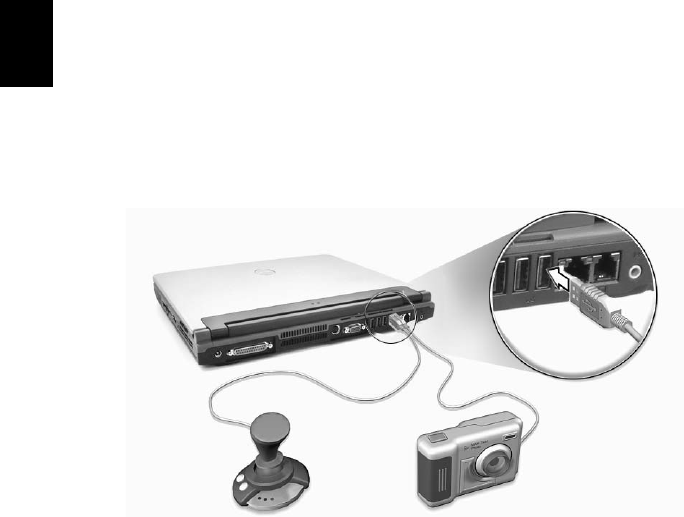
Peripherals and options
40
English
USB devices
Your computer features four USB (Universal Serial Bus) 2.0 ports for
connecting a range of USB peripherals. See “External input devices” on
page 39, and “Printer” on page 42 for information on connecting a
USB keyboard, keypad, mouse or printer. Other common USB devices
include digital cameras, scanners, and external storage devices.
USB is plug and play, which means that you can connect and start using
a USB device without having to restart your computer. You can also
disconnect the device at any time.
A further advantage of USB is the ability to use USB hubs. This means
that several devices can share a USB port simultaneously.
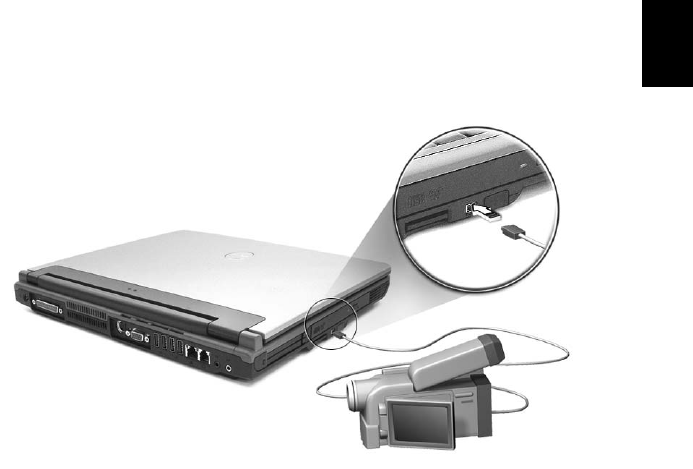
41
English
English
IEEE 1394 Port
The computer’s IEEE 1394 port allows you to connect to an IEEE 1394
supported device like a digital video camera.
See your video or digital camera’s documentation for details.

Peripherals and options
42
English
Printer
Your computer supports both parallel and USB printers.
Refer to the printer's manual for information on:
• Setting up the hardware.
• Installing the necessary drivers in Windows.
• Operating instructions.
To use a USB printer, simply connect the device to one of your
computer's USB ports, and then wait for Windows to find the new
hardware.
To connect a parallel printer, first shut down the operating system.
Connect the printer to the parallel port, and then restart the computer.
Wait for Windows to find the new hardware.
Audio devices
Your computer offers built-in stereo speakers. See the section entitled
“Audio” on page 26 for more information on these features. However,
in addition to the integrated devices, the two audio ports on the rear
side of the unit enable you to connect external audio input and output
devices.
You can plug an external microphone into your computer's
microphone-in jack. This offers the convenience of greater freedom of
movement, as well as improved audio input quality.
Connect headphones to the headphone jack for private listening and
improved audio output quality.

43
English
English
Expansion devices
PC Card
Your computer features two PC card slots that support two standard
Type II or one Type III CardBus (PCMCIA). This greatly increases your
computer's usability and expandability. A variety of PC cards are
available, such as flash memory, SRAM, fax/data modem, LAN, and SCSI
cards. Consult your dealer for information on PC card options for your
computer.
Note: Refer to your card's manual for details on how to install and
use the card.
To insert a PC Card:
1 Align the card with your computer's PC card slot. Make sure that
the edge with the connectors is facing the slot, and that the card is
the right way up. Many cards are marked with an arrow to help
you insert them correctly.
2 Slide the card into the slot, and push gently until the card
connects.
3 If necessary, connect the card's cable to the jack on the outer edge
of the card.
4 Windows will automatically detect the card's presence.
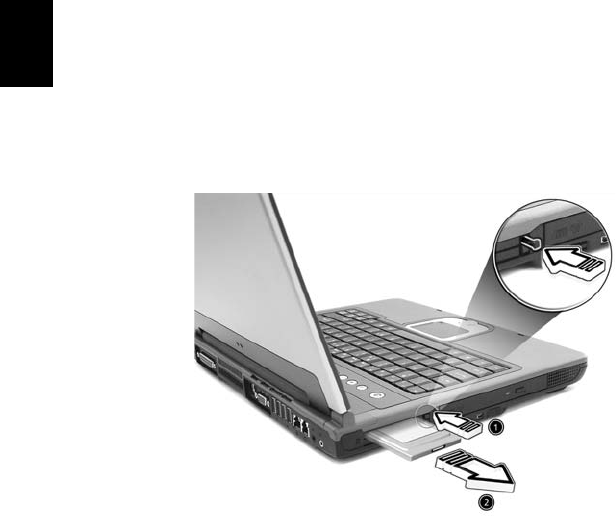
Peripherals and options
44
English
To remove a PC card:
1 Close the application that is using the PC card.
2 Double click on the PC card icon on the taskbar, and then select
the option to safely remove the card. Wait for the message telling
you that it is now safe to remove the card.
3 Press the PC card eject button to partially eject the card (1).
4 Pull the card from the slot (2).

45
English
English
Miscellaneous options
Battery pack
It is a good idea to have a spare battery, especially when you travel
with your computer. This greatly increases your productive range when
you are on the move.
AC adapter
Having a spare AC adapter allows you to keep one in two different
places. For example, you could have one AC adapter at home and
another at work. This means that you don't have to carry an AC
adapter when traveling between your two base locations.
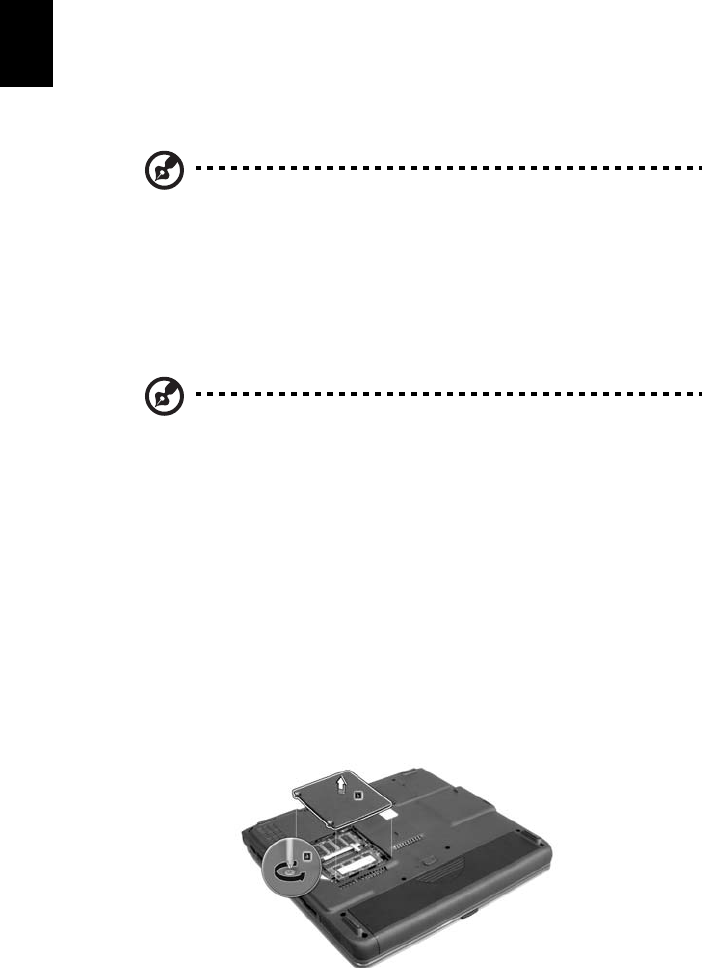
Peripherals and options
46
English
Key component upgrades
Your computer is designed to deliver solid performance. However, in
time, you might find that your applications demand even more
computing power. For this reason, you are able to upgrade key
components.
Note: Contact your authorized dealer if you decide to perform a
key component upgrade.
Memory upgrade
Memory is expandable to 2GB, employing 256/512/1024 MB dual indus-
try standard soDIMMs (Small Outline Dual Inline Memory Modules).
The computer supports DDR (Double Data Rate) SDRAM.
Note: Memory modules are strictly required to be JEDEC
compliant.
There are two memory slots on your computer. You can upgrade mem-
ory by installing a memory module into the other available slot, or
replacing the standard memory with a higher-capacity memory
module.
Installing memory:
1 Turn off the computer. Make sure that the AC adapter is
disconnected, and then remove the battery pack.
2 Turn the computer over to access the memory compartment on the
bottom of the unit. Remove all screws (a) from the memory
compartment door, and then lift the door off (b).
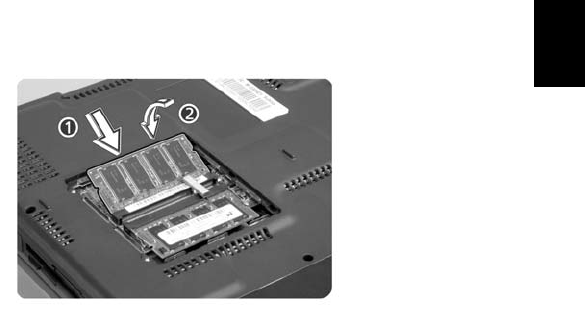
47
English
English
3 Insert the memory module diagonally in the slot (1), and then
press down gently until it clicks in place (2).
4 Replace the memory compartment door, and fasten the screw.
The computer automatically detects the new module and reconfigures
the memory.
Hard disk upgrade
It is possible to replace your hard disk with a higher capacity drive
when you need more storage space. Your computer uses a 9.5mm 2.5-
inch Enhanced-IDE hard disk. Consult your dealer if you need to
perform a hard disk upgrade.

Peripherals and options
48
English

Moving with your
computer

Your Aspire 1500 series notebook computer
is ideal for taking with you when you move
around.
This chapter provides tips on things to
consider when traveling with your
computer.

51
English
English
Disconnecting from the desktop
Before moving with your computer, you must turn it off and disconnect
all peripherals:
1 Save your work and close all applications.
2 Shut down Windows to turn off your computer.
3 Unplug the AC adapter from the mains outlet, and then
disconnect it from the computer.
4 Disconnect any external devices, such as a keyboard, mouse, or
printer, that are attached to your computer.
5 If you are using a security lock cable, disconnect the lock from the
computer.
6 Pack your computer in a strong, waterproof bag or case.

Moving with your computer
52
English
Moving around
Sometimes you might need to move your computer a short distance.
For example, you might need to move from your office desk to a
meeting room. In these situations, you don't have to shut down the
operating system.
Preparing the computer
First, disconnect any peripherals that you don't want to take with you.
Next close the lid, placing your computer in Standby mode. You can
now safely carry it around the building with you.
When you are ready to use your computer again, open the lid and then
press the power button to bring it out of Standby mode.
What to bring to short meetings
If your battery is fully charged, you probably won't need to take
anything else with you to the meeting.
What to bring to long meetings
For longer meetings, take along the AC adapter. You can use mains
power throughout the meeting, or you can run down your battery
first, and then connect the AC adapter after receiving the battery-low
warning.
If the meeting room does not have an available power outlet, reduce
your computer's power consumption by putting it in Standby mode
during long periods of inactivity. It is advisable to take along a spare
battery if you have one.

53
English
English
Taking the computer home
When you move between your office and home you will need to
prepare your computer for the short trip.
Preparing the computer
After disconnecting your computer from the desktop, prepare the unit
as follows:
1 Remove all media from the drives. Loaded media can damage the
drive heads during transit.
2 Pack the computer in a protective case that is padded to guard
against knocks. Make sure that the unit cannot slide around inside
the case.
Caution: Avoid packing items next to the top of the computer, as
this could result in damage to the screen.
What to bring with you
If you don't have spare items at home, it is advisable to take along the
AC adapter and this User's Guide.
Special considerations
To protect your computer in transit, it is advisable to pay attention to
the following:
• Minimize the effect of temperature changes. Keep your computer
with you instead of placing it in storage holds.
• Avoid leaving your computer in a hot car.
• Changes in temperature and humidity can cause condensation to
form within your computer. Before turning the computer on,
allow it to return to room temperature, and then check the screen
for signs of condensation. If the temperature change is greater
than 10°C (18°F), allow the computer to come to room
temperature slowly by placing it in a room with a temperature
between the outside and room temperatures.

Moving with your computer
54
English
Setting up a home office
If you frequently work on your computer at home, as well as at work, it
may be worthwhile purchasing a second AC adapter. This will allow
you to travel lighter, as you can keep an AC adapter in each location.
You might also find it worthwhile keeping a second set of peripherals
at home, such as a keyboard, keypad, mouse and printer.
Traveling with the computer
Sometimes you might need to make longer trips with your computer.
Preparing the computer
Prepare the computer as you would for moving between your office
and home. It is advisable to make sure that the battery is fully charged.
If you are traveling by air, you might be required to turn on the
computer during security checks.
What to take with you
It is advisable to take the following items with you:
• AC adapter.
• Spare, fully charged battery packs.
• Additional printer driver files (if you plan to use another printer).
• Phone and network cables (if you plan to use the computer's
modem and network connections).
Special considerations
In addition to the considerations for taking your computer home, keep
the following in mind:
• Always take your computer as carry-on luggage.
• If possible, have your computer manually inspected at security
checks. Although the computer can pass safely through security
X-ray machines, you should never expose it to a metal detector.
• If carried separately, avoid exposing floppy disks to hand-held
metal detectors.

55
English
English
Traveling internationally with your computer
Occasionally you might need to travel between countries with your
computer.
Preparing the computer
Prepare the computer as you would for normal travel. Remember to
take special precautions for air travel.
What to take with you
It is advisable to take the following items with you:
• AC adapter.
• Power cords that are appropriate for the countries you plan to
visit.
• Spare, fully charged battery packs.
• Additional printer driver files (if you plan to use another printer).
• Phone and network cables (if you plan to use the computer's
modem and network connections). Check that your modem is
suitable for the telephone system in the countries you plan to visit.
You might have to use a PC card modem in some locations.
Special considerations
In addition to the considerations for normal travel with your computer,
keep the following in mind when traveling internationally:
• Check that your power cord is suitable for the local power supply.
If necessary, purchase a power cord that meets local requirements.
Avoid using converter kits.
• If you plan to connect over a phone line, check that the computer's
modem and your phone cord are suitable for the local phone
system. If necessary, purchase a PC card modem that meets local
requirements.
• If carried separately, avoid exposing floppy disks to hand-held
metal detectors.

Moving with your computer
56
English

Software

Your Aspire 1500 series notebook computer
includes system utilities.
This chapter provides information on the
important software that comes with your
computer.
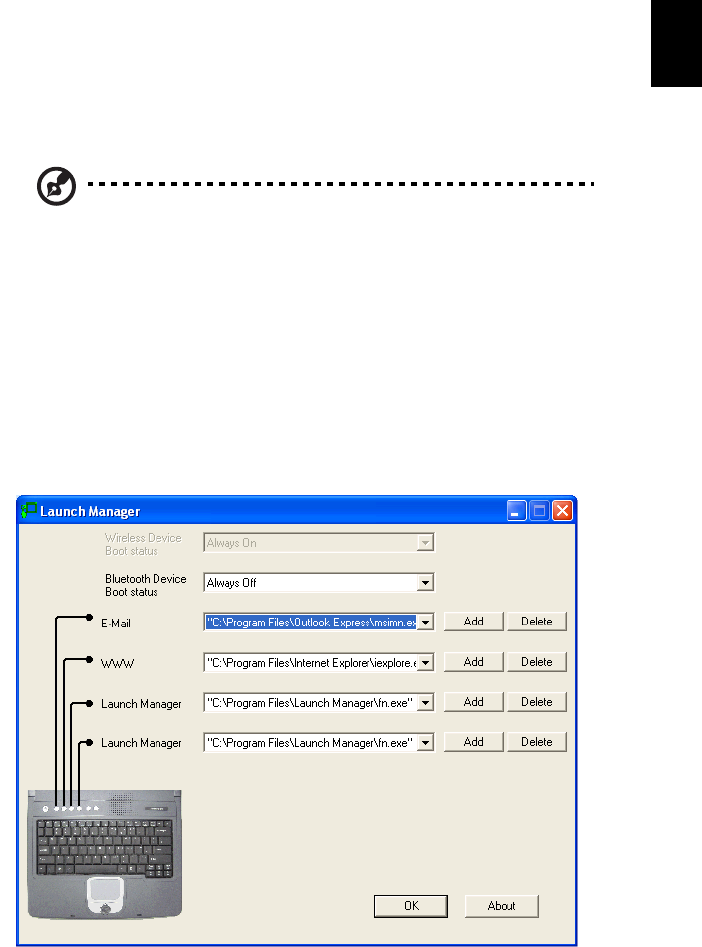
59
English
English
System software
Your computer comes preloaded with the following software:
• Microsoft Windows operating system.
• Hardware BIOS setup utility.
• System utilities, drivers and application software.
Note: To run software applications in Windows, first click on the
Start button. Next, select the appropriate folder, and then click on
the application icon. To learn about the software and utility, make
use of the online help provided by the software.
Launch Manager
Launch Manager allows you to set the four launch keys located above
the keyboard. See “Launch keys” on page 21 for the location of the
launch keys.
You can access the Launch Manager by clicking on Start, All Programs,
and then Launch Manager to start the application.
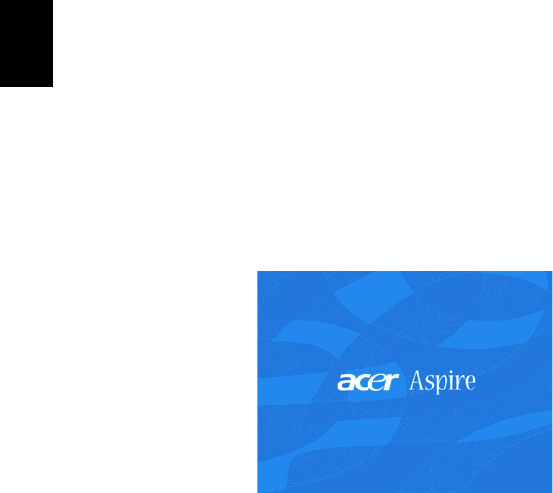
Software
60
English
BIOS Setup Utility
The BIOS (basic input/output system) contains important information
used to configure the hardware and system software settings. Your
computer reads the BIOS when it first starts up, before it loads the
operating system.
Your computer's BIOS includes a built-in setup utility called Phoenix
Software SCU (system configuration utility). It can be started shortly
after you turn the computer on, by pressing the F2 key during
Power-On Self Test (POST).
The BIOS setup utility displays summary information on your computer,
its devices, processor and memory.
Your computer is already configured for optimal performance, and so
you should not need to run this utility. However, you may need to
change the BIOS settings if you encounter configuration problems in
the future. Refer to “Frequently asked questions” on page 63 if a
problem arises.

Troubleshooting

This chapter instructs you on how to deal
with common system problems. Please read
it before calling a technician.
Solutions to more serious problems may
require opening the computer. Do not
attempt to open and service the computer
by yourself. Contact your dealer or an
authorized service center for assistance.

63
English
English
Frequently asked questions
This section suggests solutions to commonly encountered problems.
I press the power button, but my computer does not start or boot-up.
Look at the Power status indicator:
• If it is not lit, no power is being delivered to the computer. Check
the following:
- If you are running on battery power, the battery may be low
and unable to power the computer. Connect the AC adapter
to recharge the battery pack.
- If you are running on mains power, make sure that the AC
adapter is properly plugged in to the computer and to the
power outlet.
• If it is lit, check the following:
- Make sure that there is not a non-bootable (non-system)
diskette in the floppy disk drive. If so, remove the diskette and
then press Ctrl-Alt-Del to restart the system.
Nothing appears on the screen.
The computer's power management system automatically blanks the
screen to save power. Press any key to turn the display back on.
If pressing a key does not turn the display back on, check the
following:
• The brightness level might be too low. Press Fn + → hot key to
increase the screen brightness level.
• The display device might be set to an external monitor. Press the
Fn + F5 hot key to toggle the display setting.
• The system may be in standby mode. Try pressing the power
button to resume.
The image is not full-screen.
Make sure that the resolution is set to a resolution your system
supports:
• Right click on your Windows desktop and select Properties to bring
up the Display Properties dialog box. Alternatively, click on the
Display icon in Control Panel.
• Click on the Settings tab to check the resolution setting.
Resolutions lower than the specified resolution result in a display
that is less than full-screen.

Troubleshooting
64
English
There is no audio coming from my computer.
Check the following:
• The volume may be muted. In Windows, look at the volume
control icon on the taskbar. If it is crossed-out, click on the icon
and deselect the Mute option.
• The volume level may be too low. In Windows, click on the volume
control icon on the taskbar, and then use the slider control to
increase the volume level.
• If headphones are connected to the headphone jack on the
computer, your computer's built-in speakers will be turned off.
My external microphone does not work.
Check the following:
• Make sure that the external microphone is properly plugged into
the microphone-in jack on the computer.
• Make sure that the volume is not muted or set too low.
I can't eject the optical drive tray with my computer turned off.
The computer needs to be turned on for the optical drive eject button
to function. If you need to eject the optical drive tray when the
computer is turned off, push a straightened paper clip into the optical
drive emergency eject hole. See “Emergency ejection of the optical
drive tray” on page 23 for more information.
The keyboard does not respond.
Try attaching an external USB keyboard to one of your computer's USB
ports. If it works, the internal keyboard might have become
disconnected. Contact your dealer or an authorized service center.
The floppy disk drive cannot read a diskette.
Check the following:
• Make sure the diskette is properly inserted in the floppy disk drive.
• Make sure that the diskette is formatted.
• Try to read a second diskette. If this works, then the first diskette
might have a problem.
• If the diskette is not the cause of the problem, then the drive head
might be dirty. Clean it using a drive head cleaning kit.

65
English
English
The optical drive cannot read a disc.
Check the following:
• Make sure that the disc is supported by the drive. If your computer
has a CD-ROM drive, it can read CDs but cannot read DVDs. If your
computer has a DVD drive, it can read both CDs and DVDs.
• When placing a disc in the drive tray, make sure that it is secure on
the spindle of the drive tray.
• Make sure that the disc is free from scratches or smudges. If the
disc is dirty, clean it using a disc cleaning kit.
• If the disc is OK, the drive head might be dirty. Clean it using a
drive head cleaning kit.
The printer does not work.
Check the following:
• Make sure that the printer is connected to a power outlet and it is
turned on.
• Check that the cable is properly connected to the appropriate
ports on both the computer and the printer.
• If you are using a printer connected to your computer's parallel
port, restart the computer. Windows needs to find the new
hardware and install the necessary drivers.
I want to set up my location to use the internal modem.
Follow these steps:
• Click on Start, and then click on Control Panel.
• Double-click on Phone and Modem Options.
•In the Dialing Rules tab, begin setting up your location.
Refer to Windows Help for more information.
When the battery is 95-99% full, it won't charge to 100% capacity.
To preserve the life of the battery, the system only lets you charge the
battery when its capacity falls below 95%. It is recommended that you
run down the battery, and then fully recharge it.

Troubleshooting
66
English
Requesting service
International Traveler’s Warranty (ITW)
Your computer is backed by an International Travelers Warranty (ITW)
that gives you security and peace of mind when traveling. Our
worldwide network of service centers are there to give you a helping
hand.
An ITW passport comes with your computer. This passport contains all
you need to know about the ITW program. A list of available,
authorized service centers is in this handy booklet. Read this passport
thoroughly.
Always have your ITW passport on hand, especially when you travel to
receive the benefits from our support centers. Place your proof-of-
purchase in the flap located inside the front cover of the ITW passport.
If the country you are traveling in does not have an Acer-authorized
ITW service site, you can still get in contact with our offices worldwide.
Please consult www.acersupport.com.
Before you call
Please have the following information available when you call Acer for
online service, and please be at your computer when you call. With
your support, we can reduce the amount of time a call takes and help
solve your problems efficiently.
If there are error messages or beeps reported by your computer, write
them down as they appear on the screen (or the number and sequence
in the case of beeps).
You are required to provide the following information:
Name:________________________________________
Address:______________________________________
______________________________________________
Telephone number:____________________________
Machine and model type:_______________________
Serial number:_________________________________
Date of purchase:______________________________

Appendix A
Specifications

This appendix lists the general specifications
of your computer.

69
English
English
Microprocessor
• The AMD AthlonTM 64 processor 3000+ ~ 3400+.
Memory
• Main memory expandable to 2GB (Memory modules are strictly
required to be JEDEC compliant.)
• Dual 200-pin soDIMM sockets.
• PC2700 DDR SDRAM (Double Date Rate-Synchronous Dynamic
Random Access Memory) support.
• 512 KB flash ROM BIOS.
Data storage
• One internal 3.5", 1.44 MB floppy disk drive.
• 3-in-1 card reader supporting Secure Digital (SD), MultiMedia Card
(MMC) and Memory Stick (MS) formats.
• One E-IDE hard disk (2.5", 9.5mm, UltraDMA-100).
• One internal optical drive.
Display and video
• 14.1” or 15.0” Thin-Film Transistor (TFT) displaying at 1024 x 768
XGA resolution or 1400 x 1050 SXGA+ resolution, respectively.
• Simultaneous LCD and CRT display support.
• Dual display capability.
• S-video for output to a television or display device that support
S-video input.
• “Automatic LCD dim” feature that automatically selects the best
setting for the display in order to conserve power.
Connectivity
• Integrated Gigabit Ethernet connection.
• Built-in 56Kbps fax/data modem.
• IEEE 802.11g or IEEE 802.11a/g Wireless LAN (manufacturing option).
• Bluetooth (manufacturing option).

Appendix A Specifications
70
English
Audio
• Two built-in stereo speakers.
• MS DirectSound compatible.
• Audio ports for microphone-in and headphones.
Keyboard and pointing device
• 84/85-key Windows keyboard.
• Ergonomically-centered touchpad pointing device.
I/O ports
• Two Type II or one Type III PC CardBus (PCMCIA) slot.
• One IEEE 1394 port.
• One FIR port.
• One RJ-11 modem jack (V.90/V.92, 56K).
• One RJ-45 network jack (Gigabit Ethernet).
• One DC-in jack.
• One parallel port (ECP/EPP).
• One S-video port.
• One external monitor port.
• One microphone-in jack (3.5mm mini jack).
• One headphone jack (3.5mm mini jack).
• Four USB 2.0 ports.
Weight and dimensions
• 14.1”-display model:
- 3.3 kg (7.32 lbs).
- 326(W) x 290(D) x 38.6(H) mm
• 15.0”-display model:
- 3.4 kg (7.51 lbs).
- 326(W) x 290(D) x 42.9(H) mm

71
English
English
Environment
• Temperature:
- Operating: 5°C ~ 35°C.
- Non-operating: -20°C ~ 65°C.
• Humidity (non-condensing):
- Operating: 20% ~ 80% RH.
- Non-operating: 10% ~ 90% RH.
Operating system
• Microsoft Windows XP operating system.
Power
• 95W 12-cell Li-Ion battery pack.
• 120W AC adapter 19V/4.74A.
Options
• 256 MB memory upgrade module.
• Additional AC adapter.
• Additional Li-Ion battery pack.

Appendix A Specifications
72
English

Appendix B
Notices

This appendix lists the general notices for
your computer.

75
English
English
FCC notice
This device has been tested and found to comply with the limits for a Class B
digital device pursuant to Part 15 of the FCC Rules. These limits are designed to
provide reasonable protection against harmful interference in a residential
installation. This device generates, uses, and can radiate radio frequency energy
and, if not installed and used in accordance with the instructions, may cause
harmful interference to radio communications.
However, there is no guarantee that interference will not occur in a particular
installation. If this device does cause harmful interference to radio or television
reception, which can be determined by turning the device off and on, the user
is encouraged to try to correct the interference by one or more of the following
measures:
•Reorient or relocate the receiving antenna.
•Increase the separation between the device and receiver.
•Connect the device into an outlet on a circuit different from that to which
the receiver is connected.
•Consult the dealer or an experienced radio/television technician for help.
Notice: Shielded cables
All connections to other computing devices must be made using shielded cables
to maintain compliance with FCC regulations.
Notice: Peripheral devices
Only peripherals (input/output devices, terminals, printers, etc.) certified to
comply with the Class B limits may be attached to this equipment. Operation
with non-certified peripherals is likely to result in interference to radio and TV
reception.
Caution
Changes or modifications not expressly approved by the manufacturer could
void the user's authority, which is granted by the Federal Communications
Commission, to operate this computer.
Use conditions
This part complies with Part 15 of the FCC Rules. Operation is subject to the
following two conditions: (1) this device may not cause harmful interference,
and (2) this device must accept any interference received, including interference
that may cause undesired operation.

Appendix B Notices
76
English
Notice: Canadian users
This Class B digital apparatus meets all requirements of the Canadian
Interference-Causing Equipment Regulations.
Remarque à l’intention des utilisateurs canadiens
Cet appareil numérique de la classe B respected toutes les exigences du
Règlement sur le materiel brouilleur du Canada.
Modem notices
FCC
This equipment complies with Part 68 of the FCC rules. Located on the bottom
side of the modem is a label that contains, among other information, the FCC
Registration Number and Ringer Equivalence Number (REN) for this equipment.
Upon request, you must provide this information to your telephone company.
If your telephone equipment causes harm to the telephone network, the
telephone company may discontinue your service temporarily. If possible, they
will notify you in advance. But, if advance notice is not practical, you will be
notified as soon as possible. You will also be informed of your right to file a
complaint with the FCC.
Your telephone company may make changes in its facilities, equipment,
operations, or procedures that could affect the proper functioning of your
equipment. If they do, you will be notified in advance to give you an
opportunity to maintain uninterrupted telephone service.
If this equipment should fail to operate properly, disconnect the equipment
from the phone line to determine if it is causing the problem. If the problem is
with the equipment, discontinue use and contact your dealer or vendor.
TBR 21
This equipment has been approved [Council Decision 98/482/EC - "TBR 21"] for
pan-European single terminal connection to the Public Switched Telephone
Network (PSTN). However, due to differences between the individual PSTNs
provided in different countries, the approval does not, of itself, give an
unconditional assurance of successful operation on every PSTN termination
point. In the event of problems, you should contact your equipment supplier in
the first instance.

77
English
English
Telecommunications notices
A-Tick notice
For safety reasons, only connect headsets with a telecommunications
compliance label. This includes customer equipment previously labelled
permitted or certified.
Important safety instructions
Read these instructions carefully. Save them for future reference.
1Follow all warnings and instructions marked on the product.
2Unplug this product from the wall outlet before cleaning. Do not use
liquid cleaners or aerosol cleaners. Use a damp cloth for cleaning.
3Do not use this product near water.
4Do not place this product on an unstable cart, stand, or table. The product
may fall, causing serious damage to the product.
5Slots and openings are provided for ventilation; to ensure reliable
operation of the product and to protect it from overheating. These
openings must not be blocked or covered. The openings should never be
blocked by placing the product on a bed, sofa, rug, or other similar surface.
This product should never be placed near or over a radiator or heat
register, or in a built-in installation unless proper ventilation is provided.
6This product should be operated from the type of power indicated on the
marking label. If you are not sure of the type of power available, consult
your dealer or local power company.
7Do not allow anything to rest on the power cord. Do not locate this
product where persons will walk on the cord.
8If an extension cord is used with this product, make sure that the total
ampere rating of the equipment plugged into the extension cord does not
exceed the extension cord ampere rating. Also, make sure that the total
rating of all products plugged into the wall outlet does not exceed the fuse
rating.
9Never push objects of any kind into this product through cabinet slots as
they may touch dangerous voltage points or short out parts that could
result in a fire or electric shock. Never spill liquid of any kind on the
product.
10 Do not attempt to service this product yourself, as opening or removing
covers may expose you to dangerous voltage points or other risks. Refer all
servicing to qualified service personnel.
11 Unplug this product from the wall outlet and refer servicing to qualified
service personnel under the following conditions:

Appendix B Notices
78
English
aWhen the power cord or plug is damaged or frayed.
bIf liquid has been spilled into the product.
cIf the product has been exposed to rain or water.
dIf the product does not operate normally when the operating
instructions are followed. Adjust only those controls that are covered
by the operating instructions since improper adjustment of other
controls may result in damage and will often require extensive work
by a qualified technician to restore the product to normal condition.
eIf the product has been dropped or the case has been damaged.
fIf the product exhibits a distinct change in performance, indicating a
need for service.
12 Replace the battery with the same type as the product's battery we
recommend. Use of another battery may present a risk of fire or explosion.
13 Warning! Batteries may explode if not handled properly. Do not
disassemble or dispose of them in fire. Keep them away from children and
dispose of used batteries promptly.
14 Use only the proper type of power supply cord set (provided in your
accessories box) for this unit. It should be a detachable type: UL listed/CSA
certified, type SPT-2, rated 7A 125V minimum, VDE approved or its
equivalent. Maximum length is 15 feet (4.6 meters).
Laser compliance statement
The CD or DVD drive used with this computer is a laser product. The CD or DVD
drive's classification label (shown below) is located on the drive.
CLASS 1 LASER PRODUCT
CAUTION: INVISIBLE LASER RADIATION WHEN OPEN. AVOID EXPOSURE TO
BEAM.
APPAREIL A LASER DE CLASSE 1 PRODUIT
LASERATTENTION: RADIATION DU FAISCEAU LASER INVISIBLE EN CAS
D’OUVERTURE. EVITTER TOUTE EXPOSITION AUX RAYONS.
LUOKAN 1 LASERLAITE LASER KLASSE 1
VORSICHT: UNSICHTBARE LASERSTRAHLUNG, WENN ABDECKUNG GEÖFFNET
NICHT DEM STRAHLL AUSSETZEN
PRODUCTO LÁSER DE LA CLASE I
ADVERTENCIA: RADIACIÓN LÁSER INVISIBLE AL SER ABIERTO. EVITE
EXPONERSE A LOS RAYOS.
ADVARSEL: LASERSTRÅLING VEDÅBNING SE IKKE IND I STRÅLEN.
VARO! LAVATTAESSA OLET ALTTINA LASERSÅTEILYLLE.
VARNING: LASERSTRÅLNING NÅR DENNA DEL ÅR ÖPPNAD ÅLÅ TUIJOTA
SÅTEESEENSTIRRA EJ IN I STRÅLEN

79
English
English
VARNING: LASERSTRÅLNING NAR DENNA DEL ÅR ÖPPNADSTIRRA EJ IN I
STRÅLEN
ADVARSEL: LASERSTRÅLING NAR DEKSEL ÅPNESSTIRR IKKE INN I STRÅLEN
Lithium battery statement
The Aspire 1500 series uses the lithium battery, model 55E3 or 56E3.
CAUTION
Danger of explosion if battery is incorrectly replaced. Replace only with the
same or equivalent type recommended by the manufacturer. Discard used
batteries according to the manufacturer’s instructions.
ADVARSEL!
Lithiumbatteri - Eksplosionsfare ved fejlagtig håndtering. Udskiftning må kun
ske med batteri af samme fabrikat og type. Léver det brugte batteri tilbage til
leverandøren.
ADVARSEL
Eksplosjonsfare ved feilaktig skifte av batteri. Benytt samme batteritype eller
en tilsvarende type anbefalt av apparatfabrikanten. Brukte batterier kasseres i
henhold til fabrikantens instruksjoner.
VARNING
Explosionsfara vid felaktigt batteribyte. Anvãnd samma batterityp eller en
ekvivalent typ som rekommenderas av apparattillverkaren. Kassera anvãnt
batteri enligt fabrikantens instruktion.
VAROITUS
Päristo voi räjähtää, jos se on virheellisesti asennettu. Vaihda paristo
ainoastaan laitevalmistajan suosittelemaan tyyppiin. Hävitä käytetty paristo
valmistajan ohjeiden mukaisesti.
VORSICHT!
Explosionsgefahr bei unsachgemäßen Austausch der Batterie Ersatz nur durch
denselben oder einem vom Hersteller empfohlenem ähnlichen Typ. Entsorgung
gebrauchter Batterien nach Angaben des Herstellers.

Appendix B Notices
80
English
LCD pixel statement
The LCD unit is produced with high-precision manufacturing techniques.
Nevertheless, some pixels may occasionally misfire or appear as black or red
dots. This has no effect on the recorded image and does not constitute a
malfunction.
Macrovision copyright protection notice
This product incorporates copyright protection technology that is protected by
method claims of certain U.S. patents and other intellectual property rights
owned by Macrovision Corporation and other rights owners. Use of this
copyright protection technology must be authorized by Macrovision
Corporation, and is intended for home and other limited viewing uses only
unless otherwise authorized by Macrovision Corporation. Reverse engineering
or disassembly is prohibited.
Apparatus Claims of U.S. Patent Nos. 4,631,603, 4,577,216, 4,819,098, and
4,907,093 licensed for limited viewing uses only.

81
English
English
Note: Below regulatory information is for models with wireless
LAN and/or Bluetooth only.
Regulatory Notice
General
This product complies with the radio frequency and safety standards of
any country or region in which it has been approved for wireless use.
Depending on configurations, this product may or may not contain
wireless radio devices (such as wireless LAN and/or Bluetooth™
modules). Below information is for products with such devices.
European Union (EU)
This device complies with the essential requirements of the European
Council Directives listed below:
73/23/EEC Low Voltage Directive
•EN 60950
89/336/EEC Electromagnetic Compatibility (EMC) Directive
•EN 55022
•EN 55024
•EN 61000-3-2/-3
99/5/EC Radio & Telecommunications Terminal Equipment (R&TTE)
Directive
•Art.3.1a) EN 60950
•Art.3.1b) EN 301 489 -1/-17
•Art.3.2) EN 300 328-2
•Art.3.2) EN 301 893 * applied to 5GHz only

Appendix B Notices
82
English
* The applicable number varies according to the different Notified
Body ID No. applied to the wireless module installed in this product.
These numbers are subject to change without notice.
List of Applicable Countries
EU member states as of April 2003 are: Belgium, Denmark, Germany,
Greece, Spain, France, Ireland, Italy, Luxembourg, the Netherlands,
Austria, Portugal, Finland, Sweden, and the United Kingdom. Usage
allowed in the countries of European Union, as well as Norway,
Switzerland, Iceland and Liechtenstein. This device must be used in
strict accordance with the regulations and constraints in the country of
use. For further information, please contact local office in the country
of use.
Canada - Industry Canada (IC)
This device complies with RSS 210 of Industry Canada.
USA - Federal Communications Commission (FCC)
This device complies with Part 15 of FCC Rules. Operation is subject to
the following two conditions:
1This device may not cause harmful interference, and
2This device must accept any interference received, including
interference that may cause undesired operation.
Caution: Exposure to Radio Frequency Radiation
The radiated output power of the wireless module is far below the
Federal Communications Commission (FCC) radio frequency exposure
limits. Nevertheless, the wireless module shall be used in such a
manner that the potential for human contact during normal operation
is minimized.

83
English
English
The transmitter and the antenna are permanently installed inside the
notebook, and are specific for this model (not for generic computer).
FCC Caution: To assure continued compliance, any changes or
modifications not expressly approved by the party responsible for
compliance could void the user's authority to operate this equipment.

Appendix B Notices
84
English

85
English
English
Index
A
ACPI 35
audio 26
connecting externally 42
controlling volume 26
troubleshooting 64
B
battery pack
battery-low warning 34
caring for v
characteristics 31
charging 33
charging indicator 11
checking charge level 33
installing 32
low conditions 34
maximizing life 31
optimizing 33
removing 33
using the first time 31
BIOS Setup Utility 60
entering 60
brightness
hotkeys 17
C
caps lock 13
on indicator 11
care
battery pack v
computer iv
CD
troubleshooting 65
charging
checking level 33
cleaning
computer v
computer
bringing to meetings 52
caring for iv
cleaning v
disconnecting 51
features 9
moving around 52
on indicator 11
security 27
setting up a home office 54
taking home 53
traveling internationally 55
traveling on local trips 54
turning off iii
connections
audio 42
external display devices 39
external input devices 39
keyboard, external 39
keypad, external 39
mouse 39
printer 42
USB 40
connectivity options 24
Ethernet 24
D
diskette drive 22
display
hotkeys 16
troubleshooting 63
DVD
troubleshooting 65
E
Ethernet connection 24
Euro 17, 18
F
FAQ. See frequently-asked questions
floppy drive 22
troubleshooting 64
frequently-asked questions 63
front view 3
G
guide iii
H
hard disk 22
upgrading 47
help iii
Hibernation mode
hotkey 16
hotkeys 16

Index
86
English
I
ITW. See warranty
K
keyboard 13
connecting externally 39
hotkeys 16
lock keys 13
troubleshooting 64
Windows keys 15
keypad
connecting externally 39
L
launch keys 21
left view 5
M
media access
on indicator 11
memory
installing 46
upgrading 46
microphone
troubleshooting 64
modem
setting location 65
mouse
connecting externally 39
N
Notebook Manager
hotkey 16
notice
DVD copyright protection 80
num lock 13
on indicator 12
O
optical drive 22
options
hard disk upgrade 47
memory upgrade 46
PC Cards 43
spare AC adapter 45
spare battery 45
P
PC Card
inserting 43
removing 44
power management 35
printer
connecting 42
troubleshooting 65
problems 63
audio 64
CD 65
diskette 64
display 63
DVD 65
floppy drive 64
keyboard 64
printer 65
startup 63
R
rear view 7
right view 6
S
safety
CD or DVD 78
FCC notice 75
general instructions 77
lithium battery 79
modem notices 76
scroll lock 13
security
slot 27
service
when to call v
software
bundled 59
speakers
hotkey 17
troubleshooting 64
Standby mode
hotkey 16
status indicator 11
status indicators 11
status LCD 11
storage 22
floppy drive 22
hard disk 22
optical drive 22
support
information 66

Index
88
English
